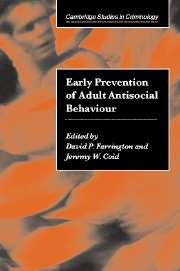Book contents
- Frontmatter
- Contents
- List of figures
- List of tables
- List of contributors
- Preface
- 1 Advancing knowledge about the early prevention of adult antisocial behaviour
- 2 Formulating strategies for the primary prevention of adult antisocial behaviour: “High risk” or ‘population’ strategies?
- 3 Risk factors for adult antisocial personality
- 4 Preventing the intergenerational continuity of antisocial behaviour: Implications of partner violence
- 5 Protective factors and resilience
- 6 Prevention during pregnancy, infancy and the preschool years
- 7 Prevention through family and parenting programmes
- 8 Prevention in the school years
- 9 Prevention of antisocial behaviour in females
- 10 Economic costs and benefits of primary prevention of delinquency and later offending: A review of the research
- 11 Conclusions and the way forward
- Index
- References
8 - Prevention in the school years
Published online by Cambridge University Press: 22 September 2009
- Frontmatter
- Contents
- List of figures
- List of tables
- List of contributors
- Preface
- 1 Advancing knowledge about the early prevention of adult antisocial behaviour
- 2 Formulating strategies for the primary prevention of adult antisocial behaviour: “High risk” or ‘population’ strategies?
- 3 Risk factors for adult antisocial personality
- 4 Preventing the intergenerational continuity of antisocial behaviour: Implications of partner violence
- 5 Protective factors and resilience
- 6 Prevention during pregnancy, infancy and the preschool years
- 7 Prevention through family and parenting programmes
- 8 Prevention in the school years
- 9 Prevention of antisocial behaviour in females
- 10 Economic costs and benefits of primary prevention of delinquency and later offending: A review of the research
- 11 Conclusions and the way forward
- Index
- References
Summary
Prevention in the school years
The trajectories toward productive citizen and antisocial adult diverge dramatically from ages six to 17. During the school years, children who will grow up to be productive citizens make great strides, beginning by learning to read, compute, control impulses, and by making friends with other children. For many, this development culminates in a love of learning, high personal and moral expectations, and pleasure found in action that strengthens the bonds of human solidarity.
During this same period, those who will become antisocial adults have difficulty learning to recognise and control their impulses without intensive instruction and reinforcement. They often have difficulty academically beginning in the late elementary grades. They lose their commitment to getting an education as a way to personal success. They are likely to use tobacco, alcohol, and other drugs earlier than their age contemporaries. They are more likely to engage in early sexual activity and are more likely to fail to complete examinations or graduate from high school.
Three major risk factors for adult antisocial behaviour become observable in individuals in school settings during the elementary grades. These include persistent physically aggressive behaviour (including fighting and bullying) (Farrington, 1991; Mrazek and Haggerty, 1994; Kellam, Rebok, Ialongo and Mayer, 1994; Robins, 1978), academic failure, and low commitment to school (Dryfoos, 1990; Maguin and Loeber, 1996). All three of these risks can be affected by intentional alterations in schools and schooling.
- Type
- Chapter
- Information
- Early Prevention of Adult Antisocial Behaviour , pp. 265 - 291Publisher: Cambridge University PressPrint publication year: 2003
References
- 12
- Cited by



